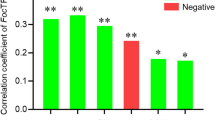Abstract
Changes in the taxonomic structure of actinomycetes in the rhizosphere of winter rye (Secale cereale L.) growing on acid soddy-podzolic soil were studied. During the first stages of ontogenesis of winter rye, the rhizosphere complex of mycelial prokaryotes was characterized by a relatively level generic structure (with respect to the indices of abundance and frequency of particular genera), low values of the species diversity, and low domination frequency of the species from the Streptomyces genus. The numbers and species diversity of the streptomycetes increased during the further growth of the winter rye, so that streptomycetes became a dominant group in the complex of the rhizosphere actinomycetes. According to the two-way ANOVA, the population density of the Micromonospora and the Streptosporangium genera in the rhizosphere was mainly dictated by the winter rye variety, whereas the population density of the streptomycetes depended on the particular stage of the winter rye development. The differences between the actinomycetal complexes characteristic of different varieties of winter rye at the early stages of its development was leveled by the end of the winter rye growth.
Similar content being viewed by others
References
G. F. Gauze, G. P. Preobrazhenskaya, M. A. Sveshnikova, et al., A Guide to Actinomycetes (Nauka, Moscow, 1983) [in Russian].
D. G. Zvyagintsev, I. P. Bab’eva, G. M. Zenova, and L. M. Polyanskaya, “Diversity of Fungi and Actinomycetes and Their Ecological Functions,” Pochvovedenie, No. 6, 705–713 (1996) [Eur. Soil Sci. 29 (6), 635–642 (1996)].
G. M. Zenova, Rare Soil Actinomycetes (Mosk. Gos. Univ., Moscow, 2000) [in Russian].
L. V. Kalakutskii and L. S. Sharaya, “Actinomycetes and Higher Plants,” Usp. Mikrobiol. 24, 26–65 (1990).
L. I. Kedrova, Winter Rye in Northeastern Russia (NIISKh Severo-Vostoka, Kirov, 2000) [in Russian].
A. V. Kil’chevskii and L. V. Khotyleva, Ecological Selection of Plants (Tekhnalogiya, Minsk, 1997) [in Russian].
P. A. Kozhevin, Microbial Populations in the Nature (Mosk. Gos. Univ., Moscow, 1989) [in Russian].
N. V. Mikhailova, O. S. Zakharova, and G. M. Zenova, “Oligosporous Actinomycetes in Soils,” Dokl. Ross. Akad. S-Kh. Nauk, No. 6, 13–16 (1998).
M. Kh. Orazova, L. M. Polyanskaya, and D. G. Zvyagintsev, “Structure of Microbial Community in the Barley Rhizosphere,” Mikrobiologiya 68(1), 127–133 (1999).
L. M. Polyanskaya, S. M. Ozerskaya, G. A. Kochkina, et al., “Abundance and Structure of Microbial Communities in Greenhouse Rose Roots,” Mikrobiologiya 72(4), 554–562 (2003).
A. S. Terekhov, “Description of Ecological Niches of Actinomycetes Based on the Analysis of Functional Parameters of Pure Cultures,” in Outlooks for Soil Biology Development (MAKS Press, Moscow, 2001), pp. 235–243 [in Russian].
I. G. Shirokikh, G. M. Zenova, and D. G. Zvyagintsev, “Actinomycetes in the Rhizosphere of Barley Grown on Strongly Acid Soddy-Podzolic Soil,” Mikrobiologiya 71(4), 533–537 (2002).
I. G. Shirokikh, O. V. Merzaeva, and A. A. Shirokikh, “Diversity of Actinomycetes in the Rhizosphere of Winter Rye on Soddy-Podzolic Soil,” in Problems of Ecology and Nature Management in the Agriculture: Proceedings of the All-Russian Scientific-Practical Conference, Izhevsk, Russia, 2003 (ANK, Moscow, 2003), pp. 294–299 [in Russian].
I. G. Shirokikh, A. A. Shirokikh, N. A. Rodina, et al., “Effects of Soil Acidity and Aluminum on the Structure of Microbial Biomass in the Rhizosphere of Barley,” Pochvovedenie, No. 8, 961–966 (2004) [Eur. Soil Sci. 37 (8), 839–843 (2004)].
D. L. Srawford, US Patent 55 275 226, 1995.
A. Gransee and L. Wittenmayer, “Qualitative and Quantitative Analysis of Water-Soluble Root Exudates in Relation to Plant Species and Development,” J. Plant Nutr. Soil Sci. 163(4), 381–385 (2000).
A. B. Maura and R. da S. Romeiro, “Actinomicetos preselectionados para controle de Risoctonia solanacearum como promotores de crescimento do tomateiro,” Rev. Ceres 47(274), 613–626 (2000).
C. C. Morse, I. V. Yevdokimov, and T. H. DeLuca, “In Situ Extraction of Rhizosphere Organic Compounds from Contrasting Plant Communitites,” Commun. Soil Sci. Plant Anal. 31(5–6), 725–742 (2000).
H. S. A. Silva, R. da S. Romeiro, and J. G. da S. Barbosa, “Actinomycetes as Biocontrol Agents for Rose Crown Gall Caused by Agrobacterium tumefaciens,” Phytophatol. 26(4), 459–463 (2000).
Author information
Authors and Affiliations
Additional information
Original Russian Text © I.G. Shirokikh, O.V. Merzaeva, G.M. Zenova, 2006, published in Pochvovedenie, 2006, No. 6, pp. 721–725.
Rights and permissions
About this article
Cite this article
Shirokikh, I.G., Merzaeva, O.V. & Zenova, G.M. Changes in the structure of the rhizosphere complex of actinomycetes in the ontogenesis of winter rye. Eurasian Soil Sc. 39, 648–652 (2006). https://doi.org/10.1134/S1064229306060093
Received:
Issue Date:
DOI: https://doi.org/10.1134/S1064229306060093




